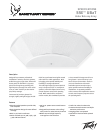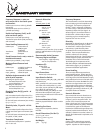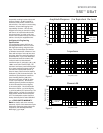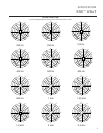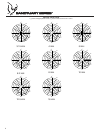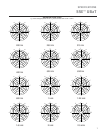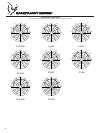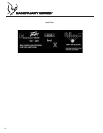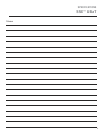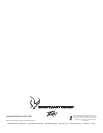
Frequency Response, 1 meter on-
axis, swept-sine in one-fourth space
environment:
8 Ohm Input: 160 Hz to 16 kHz (±3 dB with
processing)
Transformer Input
: 200 Hz to 16 kHz (+/-
3 dB with processing)
Usable Low Frequency Limit (-10 dB
point one fourth space):
8 Ohm Input: 110 Hz (with processing)
Transformer Input: 180 Hz (with processing
and crossover)
Power Handling (above 200 Hz):
8 Ohm Input: 50W continuous
100W program
200W peak
Transformer 30W continuous
Input: 60W peak
Sound Pressure Level, 1 watt, 1 meter in
anechoic environment:
8 Ohm Input: 90 dB SPL, (2.83 V input)
Maximum Sound Pressure Level
(1meter):
8 Ohm Input: 107 dB SPL continuous
113 dB SPL peak
Transformer 103 dB SPL continuous
Input, 30W tap: 106 dB SPL peak
Radiation Angle measured at -6 dB
point of polar response:
Operating Into Quarter Space:
Horizontal Dispersion: 180
º
Vertical Dispersion: 90
º
Operating Into Half Space:
Horizontal Dispersion: 180
º
Vertical Dispersion: 110
º
Directivity Factor, Ro (Q), 500 Hz – 16
kHz Mean:
Unit has textbook-perfect dispersion of Q =
4 for one-fourth space environment (180
º X
90
º )
For one-half space environment (180
º X 180º),
Q= 3.1 +1.0/-1.1
Directivity Index, Di 500 Hz – 16 kHz
Mean:
Unit has textbook-perfect dispersion of Di =
6 dB for one-fourth space environment (180
º
X 90
º )
For one-half space environment (180
º X 180º),
Di=4.8 dB, +1.2dB/-1.8 dB
Transducer Complement:
Four wide-band neodymium 2” speakers
with 1” voice coil
Harmonic Distortion:
8 Ohm In:
1% rated power (or 1W)
2nd Harmonic:
200 Hz: 0.51%
1 kHz:0.1%
3rd Harmonic:
200 Hz: .42%
1 kHz: 0.1%
10% rated power
2nd Harmonic:
200 Hz: 0.91%
1 kHz: 0.1%
3rd Harmonic:
200 Hz: 2.12%
1 kHz: 0.32%
Transformer Input
: Less than 3% up to rated
power of 30W and above 200 Hz, typically
less than 1%
.
Recommended Active Crossover
Frequency Region and Slope:
Low Frequency - High Frequency:
200 Hz at 24 dB/octave
Impedance (Z):
8 Ohm Input:
Nominal: 8W
Minimum: 7.2W
Input Connections:
Barrier strip screw terminals
Input Selection Switch:
Selects between 30W, 15W, 7.5W, 3.7W, 1.8W
or 8 Ohms Input
NOTE: 30W tap is for 70V input use ONLY!
100V input uses next tap down, e.g., with
100V input, use the 15W tap for 30W output,
the 7.5W tap for 15W output, etc.
Use of the nominally 70V 30W tap on 100V
will exceed the transformer and system
power rating, and will result in failure of the
speaker system.
Enclosure Materials & Finish:
Premium plywood finished in black or white
paint
Mounting Provisions:
Flying point for suspension, bracket
included.
Overall Dimensions (H x W x D):
3.23" x 13.78" x 6.12"
82 mm x 350 mm x 155 mm
Net Weight:
5 lbs. (2.3 kg)
Frequency Response
This measurement is useful in determining
how accurately a given unit reproduces an
input signal. The frequency response of
the SSE
™
UB2T is measured at a distance
of 1 meter using a 1 watt (into the nominal
impedance) swept-sine input signal. As
shown in figure 1, the selected drivers in
the SSE UB2T combine with the signal
processing to give a smooth frequency
response from 160 Hz to 16 kHz .
Directivity
Beamwidth is derived from the -6 dB points
from the polar plots (see figure 3) which
are measured in a whole-space anechoic
environment. Q and Directivity Index
are plotted for the on-axis measurement
position. These are specifications that
provide a reference to the coverage
characteristics of the unit. These parameters
provide insight for proper placement and
installation in the chosen environment.
The blending of the components of the
SSE UB2T exhibits a desirable beamwidth
and directivity (figure 3 & 4) suitable for
permanent installation applications.
Power Handling
There are many different approaches to
power handling ratings. Peavey rates this
loudspeaker system’s power handling using
a full-range form of the AES Standard 2-1984.
Using audio band 20 Hz to 20 kHz pink noise
with peaks of four times the RMS level, this
strenuous test signal assures the user that
every portion of this system can withstand
today’s high technology music. This rating is
contingent upon having a minimum of 3 dB
of amplifier headroom available.
Harmonic Distortion
Second and third harmonic distortions vs.
frequency for the 8-ohm input are plotted
in figures 5 & 6 for two power levels. Ten
percent (10%) of rated input power and
either one percent (1%) of rated input power
or one watt, whichever is greater. Distortion
is read from the graph as the difference
between the fundamental signal (frequency
response) and the desired harmonic. As an
example, a distortion curve that is down 40
dB from the fundamental is equivalent to 1%
distortion.
Mounting
Caution: Before attempting to suspend
this speaker, consult a certified structural
engineer. Speaker can fall if improperly
2



